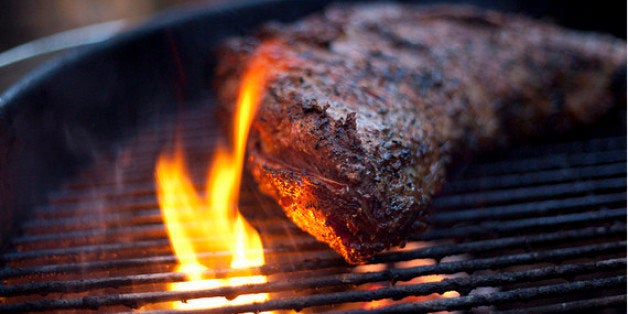
What grills like steak, but slices like brisket? Offers the beefy flavor of sirloin, but is mercifully forgiving when it comes to grilling time? If you answered tri-tip, you probably come from southern California, and if not, take a trip to Santa Maria, where you'll experience some of the best beef barbecue half the country has never experienced.
I wish I could say tri-tip was an overnight success. But this cut, known as IMPS/NAMP 185D in butcher-speak, might be the most popular cut of beef you've never heard of.
That's changing, and fast. People across North America are discovering that tri-tip is a mouthwatering cross between a steak and a roast that's perfect for grilling. It's even been hailed as "poor man's prime rib." Deluged by inquiries, the California Beef Council developed a guide to tri-tip cutting that you can print out and share with your local butcher.
So now that the introductions have been made, here are 12 things to know about tri-tip:
- In Santa Maria, which has a long history of barbecue thanks to early Spanish settlers, tri-tip is cooked on wood-burning grills with adjustable grates that are raised or lowered with a crank or pulley.
- Traditional accompaniments for tri-tip include Santa Maria-style salsa, grilled garlic bread, salad, and small pinkish-colored beans of Hispanic origin—pinquito—stewed with tomatoes, onions, and spices.
- Local red oak is the fuel of choice for grilling tri-tip on California's Central Coast: It imparts a mild smoke flavor to the meat. Though hard to find in the rest of the country, red oak smoking chips can be purchased online from Susie Q's Brand. Susie Q, aka Susan Righetti, comes from Santa Maria Valley tri-tip royalty. The website also sells dried pinquito beans and tri-tip seasonings.
- Most tri-tips (there are two per animal) weigh between 1.5 and 2.5 pounds and will serve 3 to 4 people—more if made into sandwiches. There is virtually no waste.
- Try to buy grass-fed beef when you can, preferably "Choice" or "Prime." For the ultimate splurge, try the Wagyu trip sold by Lobel's.
- Like flank steak, this lean cut is best when cooked to medium-rare (130 to 135 degrees). However, its tapered shape means the tail will be more done and can satisfy people who prefer their meat that way. The thicker center and head will still be pinkish-red.
Tri-Tip Dinner Photo by Jim Bob Barnett
SIGN UP for Steven Raichlen's UP IN SMOKE newsletter to learn more about barbecue!
--
Steven Raichlen is the author of the Barbecue! Bible cookbook series and the host of Primal Grill on PBS. His web site is BarbecueBible.com.